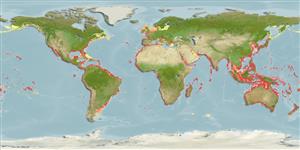Teleostei (teleosts) >
Scombriformes (Mackerels) >
Scombridae (Mackerels, tunas, bonitos) > Scombrinae
Etymology: Auxis: Greek, auxis = a variety of tunna (Ref. 45335).
More on author: Risso.
Environment: milieu / climate zone / depth range / distribution range
Ecology
Marine; brackish; pelagic-neritic; oceanodromous (Ref. 51243); depth range 10 - ? m (Ref. 9340). Tropical; ? - 28°C (Ref. 168); 61°N - 51°S, 180°W - 180°E
Atlantic, Indian and Pacific (Western): including the Mediterranean Sea. The eastern Pacific population is recognized as subspecies Auxis rochei eudorax (Ref. 32349). Highly migratory species.
Length at first maturity / Size / Weight / Age
Maturity: Lm ?, range 35 - ? cm
Max length : 50.0 cm FL male/unsexed; (Ref. 168); max. reported age: 5 years (Ref. 125574)
Dorsal spines (total): 9 - 12; Dorsal soft rays (total): 10 - 13; Anal spines: 0; Anal soft rays: 12 - 14. Back bluish, turning to deep purple or almost black on head. Scaleless area with pattern of 15 or more fairly broad, nearly vertical dark bars. Belly white. Pectoral and pelvic fins purple, their inner sides black. Body robust, elongate and rounded. Teeth small and conical, in a single series. Pectoral fins short, not reaching vertical line from anterior margin of scaleless area above corselet. A large, single-pointed flap (interpelvic process) between pelvic fins. Body naked except for corselet, which is well developed in its posterior part 9 more than 6 scales wide under second dorsal-fin origin). A strong central keel on each side of caudal-fin base between 2 smaller keels (Ref 9684).
Adults are principally caught in coastal waters and around islands (Ref. 9340). Form schools. Feed on small fishes, particularly anchovies, crustaceans (especially crab and stomatopod larvae) and squids. Eggs and larvae are pelagic (Ref. 6769). Because of their abundance, they are considered an important element of the food web, particularly as forage for other species of commercial interest. Also caught with encircling nets and troll lines (Ref. 9340). Marketed fresh and frozen (Ref. 9340) and also dried or salted, smoked and canned (Ref. 9987).
Fecundity ranges between 31,000 and 103,000 eggs per spawning according to the size of the fish.
Collette, B.B. and C.R. Aadland, 1996. Revision of the frigate tunas (Scombridae, Auxis), with descriptions of two new subspecies from the eastern Pacific. Fish. Bull. 94(3):423-441. (Ref. 32349)
IUCN Red List Status (Ref. 130435)
Threat to humans
Harmless
Human uses
Fisheries: highly commercial; gamefish: yes
Tools
Special reports
Download XML
Internet sources
Estimates based on models
Preferred temperature (Ref.
123201): 13.6 - 29, mean 26 °C (based on 6786 cells).
Phylogenetic diversity index (Ref.
82804): PD
50 = 0.5625 [Uniqueness, from 0.5 = low to 2.0 = high].
Bayesian length-weight: a=0.00955 (0.00820 - 0.01112), b=3.06 (3.02 - 3.10), in cm total length, based on LWR estimates for this species (Ref.
93245).
Trophic level (Ref.
69278): 4.4 ±0.61 se; based on food items.
Generation time: 1.8 (1.6 - 3.4) years. Estimated as median ln(3)/K based on 12
growth studies.
Resilience (Ref.
120179): Medium, minimum population doubling time 1.4 - 4.4 years (K=0.32; tm=2; Fec=31,000-103,000).
Prior r = 0.96, 95% CL = 0.64 - 1.45, Based on 1 full stock assessment.
Fishing Vulnerability (Ref.
59153): Low to moderate vulnerability (27 of 100).
Climate Vulnerability (Ref.
125649): Moderate vulnerability (38 of 100).
Nutrients (Ref.
124155): Calcium = 198 [57, 462] mg/100g; Iron = 2.28 [0.85, 5.87] mg/100g; Protein = 21.7 [19.6, 23.6] %; Omega3 = 0.364 [0.173, 0.759] g/100g; Selenium = 49.2 [18.5, 153.0] μg/100g; VitaminA = 32.7 [6.9, 148.1] μg/100g; Zinc = 1.46 [0.47, 2.70] mg/100g (wet weight); based on
nutrient studies.
